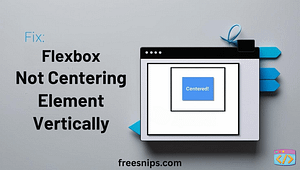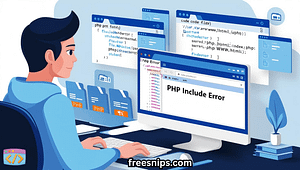So, you’re writing JavaScript, trying to make a button click or a div react to something — but nothing happens. You’ve used addEventListener, but it’s just… not working. Don’t worry — you’re not alone. This issue is super common, especially for beginners (and even experienced devs make this mistake sometimes). Let’s break it down and get it working step by step.
1. Introduction
Ever tried to make something happen on your website when a user clicks a button, but… nothing? You’ve written your JavaScript, used addEventListener, and you’re staring at a blank console, wondering what went wrong. Don’t worry, you’re definitely not alone! The addEventListener method is super powerful for making your web pages interactive, but sometimes it can be a bit finicky.
Think of addEventListener like telling your website, “Hey, when this specific thing happens (like a click), I want you to do this other thing (like show a message).” If that instruction isn’t quite right, your website will just ignore you. In this post, we’re going to break down why your addEventListener might be acting up and, more importantly, how to get it working like a charm.
2. Common Causes of the addEventListener Error
Here are the usual suspects when addEventListener refuses to work:
- You’re targeting an element that doesn’t exist yet (DOM not loaded).
- You have a typo in your selector or event name.
- The element is being overwritten or re-rendered later (like in SPAs or dynamic content).
- You’re using
getElementById,querySelector, etc., before the element is on the page. - JavaScript errors earlier in the code stopped it from running.
3. How to Fix It (Step-by-Step)
Alright, let’s get down to fixing these issues!
Step 1: Ensure Your Element Exists When the Script Runs
This is crucial. You have a few ways to make sure your element is ready:
- Move your
<script>tag to the end of<body>: This is the simplest and often recommended approach. Place your JavaScript<script>tags just before the closing</body>tag. This ensures all your HTML has been loaded and rendered before your script tries to interact with it.
<!DOCTYPE html>
<html lang="en">
<head>
<meta charset="UTF-8">
<meta name="viewport" content="width=device-width, initial-scale=1.0">
<title>My Awesome Page</title>
</head>
<body>
<button id="myButton">Click Me!</button>
<script src="myScript.js"></script>
</body>
</html>Use the defer attribute in your <script> tag: If you prefer to keep your script in the <head>, add the defer attribute. This tells the browser to download the script in the background but execute it only after the HTML document has been parsed.
<!DOCTYPE html>
<html lang="en">
<head>
<meta charset="UTF-8">
<meta name="viewport" content="width=device-width, initial-scale=1.0">
<title>My Awesome Page</title>
<script src="myScript.js" defer></script> </head>
<body>
<button id="myButton">Click Me!</button>
</body>
</html>Wrap your code in DOMContentLoaded: This event fires when the initial HTML document has been completely loaded and parsed, without waiting for stylesheets, images, and subframes to finish loading.
document.addEventListener('DOMContentLoaded', function() {
const myButton = document.getElementById('myButton');
if (myButton) { // Always a good idea to check if the element exists
myButton.addEventListener('click', function() {
console.log('Button clicked!');
});
}
});Step 2: Double-Check Your Element Selection
- Using
getElementById: Make sure the ID you’re using in your JavaScript matches the ID in your HTML exactly (case-sensitive!).
<button id="myButton">Click Me</button>const myButton = document.getElementById('myButton'); // Correct
// const wrongButton = document.getElementById('mybutton'); // Incorrect (case-sensitive)Using querySelector and querySelectorAll:
querySelectorreturns the first element that matches the CSS selector you provide.querySelectorAllreturns a NodeList (a collection) of all matching elements.
If you’re using querySelectorAll and expect to attach an event listener to multiple items, you need to loop through them:
<button class="my-class-button">Button 1</button>
<button class="my-class-button">Button 2</button>const buttons = document.querySelectorAll('.my-class-button'); // This returns a NodeList
buttons.forEach(function(button) { // Loop through each button
button.addEventListener('click', function() {
console.log('A button with class my-class-button was clicked!');
});
});- Common mistake: Doing
document.querySelectorAll('.my-class-button').addEventListener(...)will not work becauseaddEventListenerisn’t a method of a NodeList.
Step 3: Verify the Event Name
Seriously, check for typos! 'click', 'submit', 'mouseover', 'keydown', 'change', 'input' are common event types. Google “MDN event types” if you’re unsure about a specific event.
Step 4: Check the Console!
Your browser’s developer console (F12 or right-click -> Inspect -> Console tab) is your best friend. It will often show you error messages that pinpoint exactly what’s going wrong. Look for messages like “Uncaught TypeError: Cannot read properties of null (reading ‘addEventListener’)” – this usually means your element selection failed.
4. Test the Fix
Once you apply the fix, test it by clicking your button (or triggering the event you’re trying to use). If it works — boom! You’re done.
Still stuck? Use console.log() inside your function to make sure the event is firing.
element.addEventListener("click", function () {
console.log("Event triggered");
});5. Pro Tips
- Always use
console.log()to debug. - Use browser dev tools (Inspect > Console).
- Use
document.querySelector()for classes and IDs with#or.. - Try
console.log(document.getElementById("myBtn"))to check if your element exists. - Use arrow functions if you don’t need
thisinside the listener.
6. Related Errors or Alternative Scenarios
Here are some similar issues you might run into:
Uncaught TypeError: Cannot read properties of null— means your element is not found.- Adding event listeners to elements loaded dynamically (use event delegation in that case).
- Duplicate IDs causing confusion — keep them unique.
7. Conclusion
Debugging JavaScript can sometimes feel like solving a puzzle, but with addEventListener, most issues boil down to making sure your element exists when your script runs, selecting it correctly, and having the right event name. By following these steps and remembering to use your browser’s developer tools, you’ll be able to get your web pages reacting to user input in no time. Happy coding!





